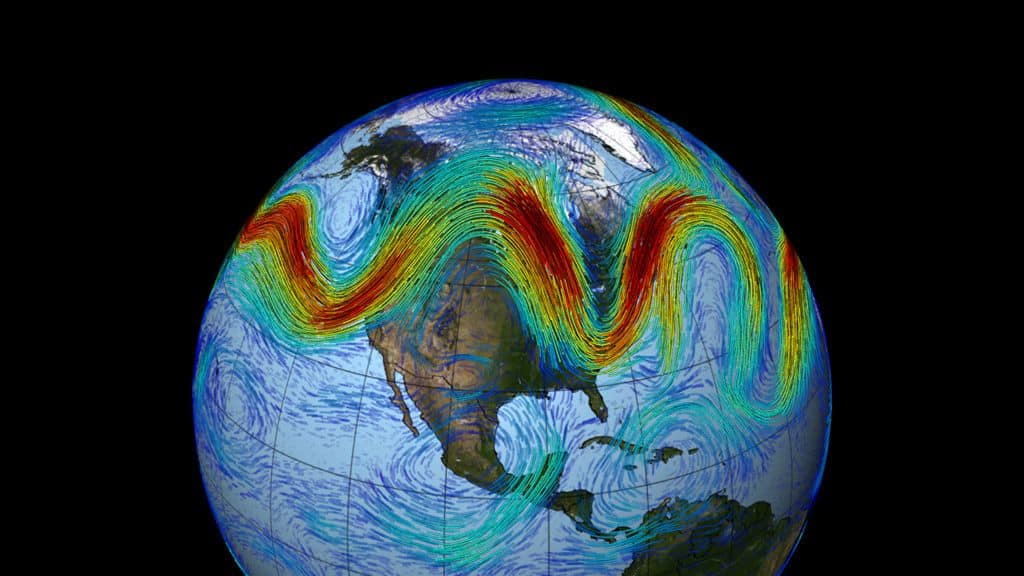About Jet Streams
- Jet streams are bands of strong wind that generally blow from west to east all across the globe.
- Earth has four primary jet streams: two polar jet streams, near the north and south poles, and two subtropical jet streams closer to the equator.
- They impact weather, air travel, and many other things that take place in our atmosphere.
- What causes Jet Streams?
- Jet streams form when warm air masses meet cold air masses in the atmosphere.
- The Sun doesn’t heat the whole earth evenly. That’s why areas near the equator are hot and areas near the poles are cold.
- So when Earth’s warmer air masses meet cooler air masses, the warmer air rises up higher in the atmosphere while cooler air sinks down to replace the warm air.
- This movement creates an air current, or wind.
- A jet stream is a type of air current that forms high in the atmosphere.
- They are located about five to nine miles above Earth’s surface in the mid to upper troposphere, the layer of Earth’s atmosphere where we live and breathe.
- Speed:
- On average, jet streams move at about 110 miles per hour.
- But dramatic temperature differences between the warm and cool air masses can cause jet streams to move at much higher speeds – 250 miles per hour or faster.
- Since these hot and cold air boundaries are most pronounced in winter, jet streams are the strongest during both the northern and southern hemisphere winters.
- How Do Jet Streams Affect Weather?
- They play a crucial role in shaping weather patterns. They can affect the movement of weather systems, such as high-pressure and low-pressure areas, and influence the direction and intensity of storms.
- Storms tend to follow the edge of the jet stream, where the difference between cool and warm air creates the turbulent conditions for storms.
- How Do Jet Streams Affect Air Travel?
- Airplanes also fly in the mid to upper troposphere. So, if an airplane flies in a powerful jet stream and they are traveling in the same direction, the airplane can get a boost.
- That’s why an airplane flying a route from west to east can generally make the trip faster than an airplane traveling the same route from east to west.
Q1) What is an Air Mass?
An air mass is a large volume of air in the atmosphere that is mostly uniform in temperature and moisture. Air masses can extend thousands of kilometers in any direction, and can reach from ground level to the stratosphere—16 kilometers (10 miles) into the atmosphere.
Source: Jet streams discovered on Jupiter that are as fast as ‘category 5’ storms on Earth
Last updated on July, 2025
→ UPSC Notification 2025 was released on 22nd January 2025.
→ UPSC Prelims Result 2025 is out now for the CSE held on 25 May 2025.
→ UPSC Prelims Question Paper 2025 and Unofficial Prelims Answer Key 2025 are available now.
→ UPSC Calendar 2026 is released on 15th May, 2025.
→ The UPSC Vacancy 2025 were released 1129, out of which 979 were for UPSC CSE and remaining 150 are for UPSC IFoS.
→ UPSC Mains 2025 will be conducted on 22nd August 2025.
→ UPSC Prelims 2026 will be conducted on 24th May, 2026 & UPSC Mains 2026 will be conducted on 21st August 2026.
→ The UPSC Selection Process is of 3 stages-Prelims, Mains and Interview.
→ UPSC Result 2024 is released with latest UPSC Marksheet 2024. Check Now!
→ UPSC Toppers List 2024 is released now. Shakti Dubey is UPSC AIR 1 2024 Topper.
→ Also check Best IAS Coaching in Delhi















